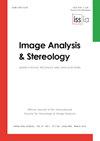基于otsu方法的果蔬图像分割改进程序。
IF 1
4区 计算机科学
Q4 IMAGING SCIENCE & PHOTOGRAPHIC TECHNOLOGY
引用次数: 0
摘要
目前,水果和蔬菜的分类、识别和检测面临着重大挑战。解决这一问题的一个重要步骤是获得感兴趣对象的准确分割。然而,由于光照不均匀或条件不佳,某些阈值分割技术在灰度图像中显示出很高的误差。一种公认的减小分割误差的策略是选择具有高对比度的RGB图像的通道。本文给出了一种基于Otsu方法的二值分割增强实验程序的结果。该程序与真实农产品的图像进行,有或没有额外的噪声,以证实所提出的策略的鲁棒性。实验采用我们的非受控光照下的农产品RGB图像数据库进行。结果表明,选择RGB测试图像的蓝色通道具有较好的对比度,因此分割效果最好。在这里,定量的结果是通过应用Jaccard和Dice度量来衡量的,这些度量基于ground-truth图像作为最佳参考。在两次实验测试中,大多数结果的平均改进百分比差异大于45.5%。本文章由计算机程序翻译,如有差异,请以英文原文为准。
IMPROVEMENT PROCEDURE FOR IMAGE SEGMENTATION OF FRUITS AND VEGETABLES BASED ON THE OTSU METHOD.
Currently, there are significant challenges in the classification, recognition, and detection of fruits and vegetables. An important step to solve this problem is to obtain an accurate segmentation of the object of interest. However, the background and object separation in a gray image shows high errors for some thresholding techniques due to uneven or poorly conditioned lighting. An accepted strategy to decrease the error segmentation is to select the channel of a RGB image with high contrast. This paper presents the results of an experimental procedure based on a binary segmentation enhancement by using the Otsu method. The procedure was carried out with images of real agricultural products with and without additional noise to corroborate the robustness of the proposed strategy. The experimental tests were performed by using our database of RGB images of agricultural products under uncontrolled illumination. The results exhibit that the best segmentation is based on the selection of the Blue channel of the RGB test images due to its better contrast. Here, the quantitative results are measured by applying the Jaccard and Dice metrics based on the ground-truth images as optimal reference. Most of the results show an average percentage improvement difference greater than 45.5% in two experimental tests.
求助全文
通过发布文献求助,成功后即可免费获取论文全文。
去求助
来源期刊

Image Analysis & Stereology
MATERIALS SCIENCE, MULTIDISCIPLINARY-MATHEMATICS, APPLIED
CiteScore
2.00
自引率
0.00%
发文量
7
审稿时长
>12 weeks
期刊介绍:
Image Analysis and Stereology is the official journal of the International Society for Stereology & Image Analysis. It promotes the exchange of scientific, technical, organizational and other information on the quantitative analysis of data having a geometrical structure, including stereology, differential geometry, image analysis, image processing, mathematical morphology, stochastic geometry, statistics, pattern recognition, and related topics. The fields of application are not restricted and range from biomedicine, materials sciences and physics to geology and geography.
 求助内容:
求助内容: 应助结果提醒方式:
应助结果提醒方式:


